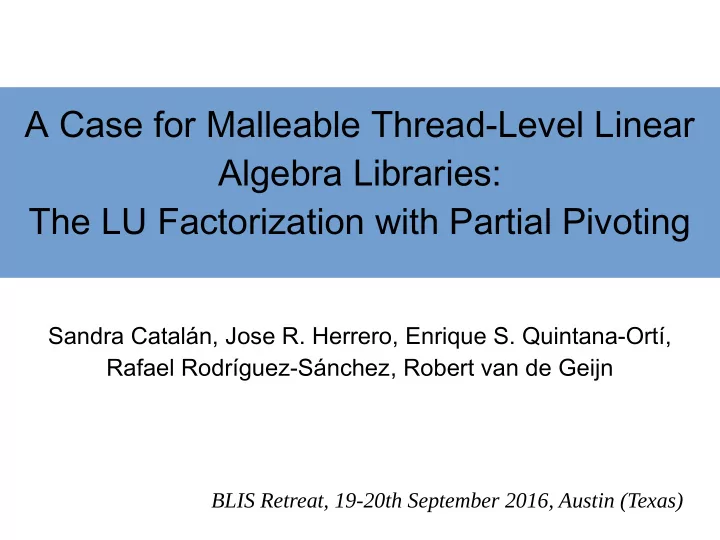

A Case for Malleable Thread-Level Linear Algebra Libraries: The LU Factorization with Partial Pivoting Sandra Catalán, Jose R. Herrero, Enrique S. Quintana-Ortí, Rafael Rodríguez-Sánchez, Robert van de Geijn BLIS Retreat, 19-20th September 2016, Austin (Texas)
Motivation Increase number of threads BLAS → TLP Nested TLP + TP LAPACK → TP (runtime) 2
Why malleability Ta 3th Tb 5th . . . . Ta . . . Tb 3
Why malleability Ta 3th Tb 5th Ta 3th Tb 5th . . . . . . . . Ta . Ta . . . . Tb 8th Tb DLA library modification to allow number of threads expansion 3
LU as an example b size is important: - Too small → Low GEMM performance - Too large → Too many panel factorization flops 4
Optimal block size 5
Optimal block size 6
The panel factorization relevance Less than 2% of the flops 17.5% of the time 7
Dealing with the panel factorization Look-ahead: Overlap the factorization of the “next” panel with the update of the “current” trailing submatrix. 8
Look Ahead LU 9
Our setup ● Intel Xeon E5-2603 v3 ● 6 cores at 1.6 Ghz ● BLIS 0.1.8 ● BLIS Loop 4 ( jr ) parallelized ● Extrae 3.3.0 ● Panel factorization via blocked algorithm ● Two block sizes b o and b i ● Inner LU involve small-grained computations and little parallelism 10
Look Ahead LU Performance 11
Look Ahead LU Performance 11
Towards malleability ● P threads in the panel factorization ● R threads in the update ● Panel factorization less expensive than update – P threads will join R team eventually – BLAS does not allow to modify the number of working threads 12
Static re-partitioning ● Workaround: split the update into several GEMM ● Drawbacks: – Lower GEMM throughput (packing and suboptimal blocks) – Decision on which loop to parallelize and the granularity of the partitioning 13
Malleable thread-level BLAS ● Solving static partitioning issues: – Only one GEMM call → no extra data movements – BLIS takes care of the partitioning and granularity 14
How Malleability behaves 15
And the small case... 15
What if panel factorization is more expensive than the update ● If R finish before P → Stop panel factorization – RL LU. Keep a copy of the panel – Use LL LU. Sincronization among threads follows the same idea 16
Look ahead via runtimes ✔ TP execution ✔ Adaptative-depth look-ahead ✗ Re-packing and data movements (many GEMM calls) ✗ Block size fixes the granularity of the tasks ✗ Rarely exploit TP+TLP 17
Experimental results ● LU, LU_LA, LU_MB, LU_OS ● Square matrices from n=500 to n=12,000 ● b o was tested for values from 32 to 512 in steps of 32 ● b i was evaluated for 16 and 32 18
Performance comparison 19
Performance comparison 20
Conclusions ● Malleable implementation of DLA library ● Competitive results (small matrices) ● Pending strategies to be applied (Early termination) 21
THANK YOU
Recommend
More recommend